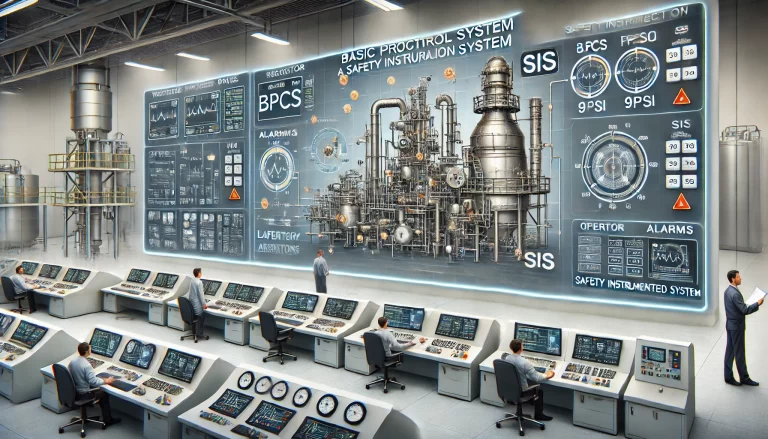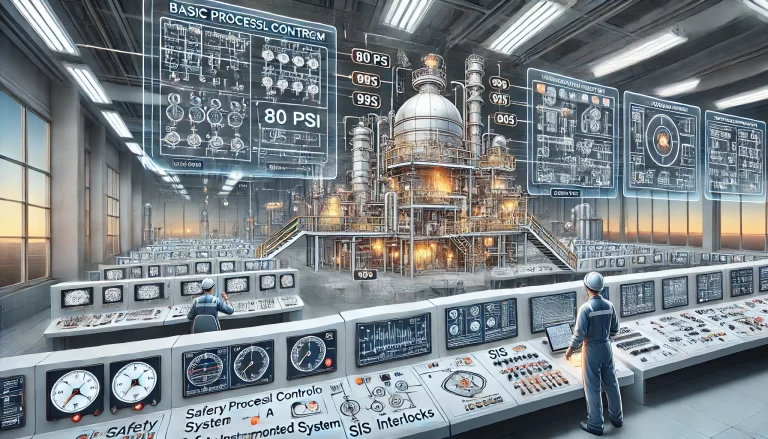In industrial operations, the Basic Process Control System (BPCS) and the Safety Instrumented System (SIS) serve distinct but complementary roles in ensuring safe and efficient operations. While the BPCS focuses on the continuous control and monitoring of processes, the SIS is designed to detect hazardous conditions and execute safety-critical interlocks to prevent incidents. Understanding their relationship and interaction is key to achieving a robust safety management framework.

Roles and Functions
BPCS (Basic Process Control System):
- Primary Function: The BPCS is responsible for controlling process variables such as temperature, pressure, flow, and level, ensuring they remain within operational limits. It continuously monitors the system and adjusts parameters to maintain stability and efficiency.
- Alarm Mechanism: BPCS alarms are configured to notify operators when a process variable deviates from the normal operating range. These alarms are intended as a first line of defense, prompting manual intervention by the operator to restore normal conditions.
SIS (Safety Instrumented System):
- Primary Function: SIS acts as a protective barrier designed to mitigate risks in situations where the BPCS alone cannot prevent hazardous conditions. Its purpose is to detect abnormal scenarios and take predefined actions (e.g., shutting down equipment or activating safety measures) to protect personnel, equipment, and the environment.
- Interlock Mechanism: SIS interlocks are typically triggered when a process variable reaches a critical threshold that poses an immediate safety risk. The system executes automatic actions without relying on operator input to prevent escalation.

Coordination Between BPCS and SIS
Alarm Levels and Thresholds:
- BPCS alarms are usually configured at a level lower than the SIS interlock thresholds. For instance, if a pressure vessel’s safety limit is 100 psi, a BPCS alarm might be set at 80 psi to alert the operator of abnormal conditions. The SIS interlock, however, could be configured at 95 psi, ensuring automatic action before the pressure exceeds the safe limit.
- This staged configuration provides operators with an opportunity to address potential issues early through manual intervention, reducing the likelihood of the SIS being triggered.
Operator Response:
- When a BPCS alarm is activated, it relies on operators to investigate and resolve the issue promptly. Operators might adjust process parameters, inspect equipment, or initiate a controlled shutdown to stabilize the system.
- If the operator’s response is delayed or ineffective and the parameter continues to deviate towards a hazardous state, the SIS takes over by executing safety interlocks automatically.
Example Scenario:
Consider a chemical reactor where temperature control is critical:
- The BPCS alarms if the temperature rises above the normal range, prompting the operator to cool the system or reduce the reaction rate.
- If the temperature continues to rise despite operator efforts, the SIS intervenes by shutting down the reactor or opening a relief valve to prevent catastrophic failure.

Independence and Redundancy
A critical design principle is the independence between BPCS and SIS. Both systems must operate independently to avoid a single point of failure. For example:
- A malfunction in the BPCS should not compromise the SIS’s ability to execute interlocks.
- SIS components are often built to higher reliability standards and may include redundant hardware to ensure fail-safe operation.
Layered Protection Approach:
The coordination between BPCS and SIS exemplifies the Layer of Protection Analysis (LOPA) methodology, where multiple independent safety layers address risks at different levels:
- BPCS Alarms: Early warning for operator intervention.
- SIS Interlocks: Automatic action as a last line of defense.
- Physical Barriers: Additional safeguards like pressure relief devices or containment systems.

Best Practices for Integration
Clear Alarm and Interlock Hierarchy:
Ensure that alarm levels are well-documented and lower than SIS thresholds to avoid confusion and ensure timely operator response.Operator Training:
Provide comprehensive training to operators so they can effectively interpret and respond to BPCS alarms.Periodic Testing and Maintenance:
Regularly test and maintain both systems to ensure reliable performance and adherence to safety standards.Independent Validation:
Conduct thorough checks to verify that the BPCS and SIS are configured correctly and independently.

Conclusion
The interaction between BPCS alarms and SIS interlocks is foundational to industrial safety. While the BPCS provides an initial warning and an opportunity for manual intervention, the SIS serves as a fail-safe mechanism, ensuring that critical actions are taken automatically when needed. This layered approach not only enhances operational safety but also minimizes downtime and prevents costly incidents. By maintaining independence and ensuring robust coordination, these systems work together to create a safer and more efficient industrial environment.
